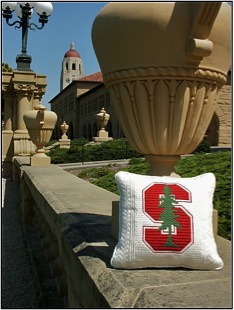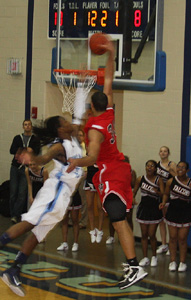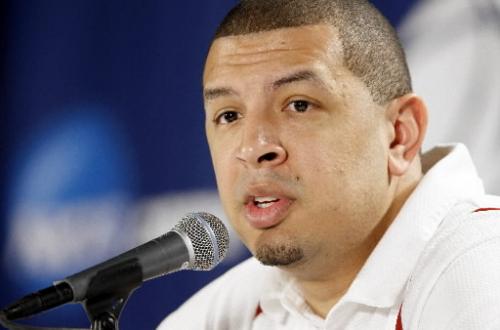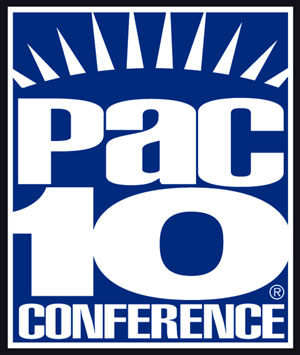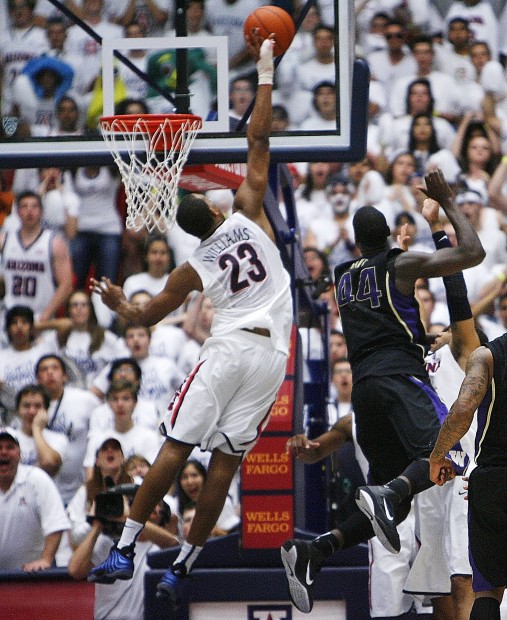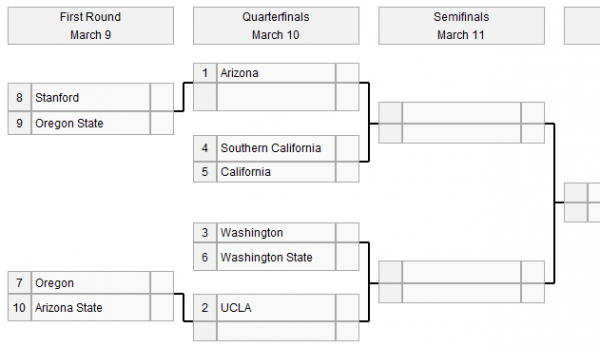
Andrew Murawa is the RTC correspondent for the Mountain West and Pac-10 conferences.
A Look Back
A week ago, the conference was all but won. Arizona had a two game lead, and even with a Los Angeles road trip looming, it looked like it would take a complete collapse for the Wildcats to lose their grip on the Pac-10. But a week later, USC is riding a four-game winning streak, UCLA has won eight of its last nine, Arizona has dropped two in a row and now we’re left with the Wildcats and the Bruins tied atop the conference. And yet, this is still the Wildcats’ conference to lose. While UCLA heads north to visit the Washington schools this week, Arizona heads back home to host the Oregon schools. If the ‘Cats can take care of business in the McKale Center, UCLA would need to complete a road sweep of the Huskies and Cougars in order to seal the tie at the top of the conference. More importantly, with Selection Sunday just a week and a half away, both UCLA and Arizona have basically sewn up at-large bids, but Washington, once considered the obvious favorite in the Pac-10 and a shoo-in for NCAA inclusion, has put its NCAA at-large candidacy back in question. A closer look at their resume reveals only a home win over Arizona and a road win over UCLA as wins to hang their hat on, with their win over Long Beach State their only other win over likely participants in the NCAA Tournament. While the bubble at the back of the line is probably soft enough for the Huskies to still get in, they surely want to wrap up the season in style with wins over UCLA and USC in order to ease their worried minds.
- Team of the Week: UCLA – Back from the dead, the Bruins now sit back where Westwood expects them to sit: atop the Pac-10 standings. After last year’s disastrous 14-18 season, the Bruins worst season since Ben Howland’s first year of rebuilding after the Steve Lavin era ended in ruins, after a frightening home loss to Montana to cap a four-game losing streak back in December, after the fourth consecutive loss to cross-town rival USC in their first meeting this season, the Bruins being tied atop the Pac-10 in March seemed exceedingly unlikely. And while this Bruin team looked decidedly ordinary over the course of the Pac-10 schedule, all of a sudden they are playing their best ball of the year. Without a doubt, the Bruins’ 22-point thrashing of Arizona in the final game at Pauley Pavilion before it begins renovations, a game in which John Wooden’s great-grandson, Tyler Trapani, scored the final basket ever recorded in the building’s grand history, was the best Bruin performance in the past two seasons. While they still have a lot to prove in the coming days and weeks, the fact that this team is beginning to gel just as the calendar turns to the most important month in the sport is of great comfort to Bruin fans.
- Player of the Week: Nikola Vucevic, Junior, USC – In the story of the Trojans’ sudden rebirth, Vucevic is the leading man. While the junior from Montenegro has been very good all season long, averaging 17.5 PPG and 10.3 RPG, over the Trojans four-game winning streak he has been nothing short of excellent. In that span he has averaged 21.3 points and 11.5 rebounds, has knocked down eight of his twelve attempts from beyond the arc and has scored over 30% of USC’s points. If Vucevic can keep his Trojans on their winning ways in Washington this weekend, USC may be just good enough to sneak back into bubble conversations in advance of the Pac-10 Tournament.
- Newcomer of the Week: Allen Crabbe, Freshman, California – Well, I think he’s back. After sparkling through much of the first 11 games in the conference season, Crabbe’s excellent rookie campaign hit a major speed bump when he suffered a concussion against Washington on February 10. He missed the rest of that game, two more games and was clearly not back to full strength when he did return against UCLA, but this week he proved that he is ready to go forward at full strength. This week he scored 45 points, knocked down ten of his 16 three-point attempts and grabbed eight rebounds in helping his Golden Bears to a sweep of the Oregon schools.
- Game of the Week: USC 65, Arizona 57 – There were nine games this week, and none closer than USC’s eight-point upset win over the Wildcats on Thursday night. While this was by no means a thing of beauty (the teams combined for six assists on 40 field goals, the Trojans went 1-10 from three and shot just over 40% from the field, and still won with relative ease), the result did send shockwaves around the conference, as Bruin fans were forced to admit that they were pulling for the Trojans – and hard. In the end, USC got two big blocked shots by Alex Stepheson and Marcus Simmons after the Wildcats came back to tie the game at 56, and the Trojans converted those defensive plays into four made free throws on the offensive end. Vucevic led the way for the Trojans with 25 points and 12 rebounds, while junior point Jio Fontan had by far his best game since his first week of eligibility, posting 21 points and adding three assists. But the big key for the Trojans had to be limiting Arizona’s Derrick Williams to just 3-11 shooting, just two free throw attempts (seven below his season average) and just eight total points – his first game of the season in which he failed to score in double figures.
- Game of the Upcoming Week: UCLA (21-8, 12-4) at Washington (19-9, 10-6), 3/3, 6pm PST, ESPN2 – Between the two teams tied at the top of the conference heap, the Bruins have by far the toughest road remaining. The Huskies have lost just once at home all season, and just four times in the last three years, and UCLA hasn’t won at the Hec Ed since 2004. But, they’ve got to assume that they need two wins in their remaining two games in order to tie for the Pac-10 title, and if they’re to rise to that challenge, it starts here. In the first matchup, the Huskies strung together a 27-10 run spanning halftime to break open a close game and propel them to an eventual 11-point win at Pauley. In that game Joshua Smith fouled out in a relatively ineffective 22 minutes, Lazeric Jones was completely absent, nobody off the Bruin bench made a field goal and the Huskies shot the Bruins out of the gym. For UCLA to get this win, Howland would like to see Smith stay out of foul trouble, pound the Huskies in the paint and get some offensive contributions from Jones. Even if UCLA can pull off this difficult road win, they’ll need to back it up with a win at Washington State on Saturday to ensure a Pac-10 title.
Power Rankings
1. Arizona (23-6, 12-4): I’ve been saying all year long that if opponents can limit Williams offensively, the ‘Cats don’t have enough firepower on the rest of their roster to beat good teams. We learned this against BYU and we learned this against Oregon State. Of course, then Arizona and Momo Jones and Kevin Parrom shot that theory down in dramatic fashion in triple overtime against Cal, but in the back of my mind, I still didn’t buy this Wildcat squad as an elite team. Fast forward to the last week in February, when USC and UCLA held Williams to 23 points on 8-22 shooting and just six total free throw attempts in handing the Wildcats a oh-for-L.A. weekend. No other Wildcat was able to score more than 12 points in his place over the weekend (Jesse Perry had 12 against USC, Parrom added ten in that game and Kyle Fogg had ten against UCLA) and the rest of the roster combined to shoot a less-than-impressive 32.9% from the field. This is still a good Arizona team, but the concept of this squad being a top ten team (where it was ranked last week) is ludicrous. The concept of this squad even being a top 25 team (where it is still ranked) is still a stretch.
Looking ahead: The Wildcats return to the McKale Center this week, and need to stop the bleeding immediately by avenging their opening weekend loss to Oregon State on Thursday. Then they wrap up the season on Saturday by hosting Oregon. Arizona needs both of these games.
2. UCLA (21-8, 12-4): Sometimes basketball is a pretty simple game. Sure, you’ve got to make your shots, and you can have cold shooting nights that doom you or hot shooting nights by opponents that do the same. But the fact of the matter is, if you play tough defense, rebound well and don’t turn the ball over, you’re most of the way there. And, in those areas, the Bruins are suddenly looking good. At the start of the year, their defense was not up to par. In particular, the loss to Virginia Commonwealth in Madison Square Garden was abysmal, the type of defense that Bruin fans hated seeing last season. But in conference play, things have turned around and now this UCLA squad is excellent defensively. But the biggest factor this weekend in the Bruins’ sweep of the Arizona schools may have been their total of 16 turnovers for the weekend. Considering that the Bruins turned the ball over 18 times against Cal, 19 times in their win over St. John’s and their loss at Arizona, and even 26 times in their win over Oregon State, the eight turnovers that they posted in each game this weekend was a critical improvement. In order for the Bruins to be a serious threat come the NCAA Tournament, they’ll need to keep those turnover totals similarly low.
Looking ahead: Washington on Thursday night and Washington State on Saturday, a pair of games that make up the toughest road trip in the Pac-10. And the Bruins need to win both to secure a conference title.
3. Washington (19-9, 10-6): The Huskies have this rationalization to fall back on, following their home loss to Washington State on Sunday: they didn’t play that bad. The Huskies dominated the offensive glass, grabbing 23 rebounds, exactly 50% of every missed shot that came off the rim on the offensive end. But, they turned the ball over 16 times, missed far too many of the put-back attempts and shot a lowly 36.6% from inside the three-point arc. All in all, Lorenzo Romar and company have to forget about this game and take care of business this week against the hot Los Angeles schools that are coming storming through Seattle. Anything less than a sweep and the Huskies are limping into the Pac-10 tourney.
Looking ahead: UCLA on Thursday, USC on Saturday.
4. USC (17-12, 9-7): Out of nowhere, a four-game winning streak (they had not won more than two-in-a-row all season) and a newly formidable Trojan squad. Vucevic has been excellent all year, but USC is at its best when his frontcourt mate Stepheson is a major contributor. During the four-game winning streak, he has average 13 points and nine rebounds a game, while during the seven Pac-10 losses he has averaged just over seven points and rebounds per game. The Trojans are 11-4 when he scores in double figures, just 6-8 when he does not. The numbers are clear: Kevin O’Neill needs Stepheson to provide a threat alongside Vucevic for USC to be at its best.
Looking ahead: If USC can continue its streak and get wins at Washington State and Washington, you’d have to say their resume (which would then include wins over Texas, at Tennessee, UCLA, Arizona and at Washington) would be superior to the Huskies. A couple more wins in the Pac-10 tourney could be enough to get them dancing.
5. Cal (16-13, 9-8): I think a lot of people would probably go with Washington State as the next best team in the conference, but Cal has proven to be the more dangerous, more balanced team over the course of conference play. Despite a four-game swoon in February that coincided rather clearly with Crabbe’s four-game absence (Crabbe’s concussion overlapped with three of the four losses), the Golden Bears have been impressive this season under Mike Montgomery’s excellent guidance. Junior Jorge Gutierrez has improved dramatically from the hustling role-player that he portrayed in his first two years on campus, and stepped it up even more spectacularly of late, scoring in double figures in his last ten games and averaging 20.3 PPG, 5.4 APG and 4.2 RPG over that span. Crabbe, too, has shown rapid improvement under Montgomery; after taking a couple months to get comfortable, he has been clearly the best freshman in conference play, averaging 18.4 PPG (excepting the two games around his concussion) since the abrupt transfer of fellow freshman Gary Franklin after the first Stanford game. Likewise, sophomore Brandon Smith, who averaged less than seven minutes per game last year, has been transformed into a solid Pac-10 level point guard since the Franklin departure, averaging 11.4 PPG and 5.1 APG in the 16 games since. And with Markhuri Sanders-Frison and Harper Kamp doing yeoman’s work up front, this is a seriously tough Cal team that could cause a lot of problems in the Pac-10 tourney.
Looking ahead: The Bears wrap up the season with a visit from Stanford on Saturday.
6. Washington State (18-10, 8-8): The mere fact that I’m putting a team as good as this Cougar team as the sixth best team in the conference indicates that while the Pac-10 is not back to the glory days of Kevin Love, the Lopez twins, James Harden and O.J. Mayo (among numerous others), this conference has come a long ways since last year’s mediocre conference. However, the fact that a team this talented is just .500 in the conference raises some other questions. We’ll save those for later, however, as the Cougs are coming off an big win over Washington on Sunday, a game during which they got to the line 36 times and made a mighty impressive 32. Sure, they turn the ball over too much, and they still can get killed on the glass (witness the 23 offensive rebounds they gave up Sunday), but Klay Thompson is one of the best scorers in the nation, DeAngelo Casto is a big, bouncy forward who has turned it on lately (15.5 PPG and 8.0 RPG over the last six games) after an injury-riddled start to the season and Ken Bone is blessed with plenty of willing role players. Much like USC and Cal, this team may need to win the Pac-10 Tournament to get invited to the NCAA Tournament (so far their resume consists of a win over Gonzaga and a season sweep of Washington), but they’re very capable of doing so.
Looking ahead: The Cougars host USC and UCLA this weekend, and they’ll need to prove in those games that their win at Washington wasn’t just a one-off blip before anyone should take them too seriously.
7. Oregon (14-14, 7-9): Home losses to the Bay Area schools this week put a damper on the buzz surrounding the Ducks, but head coach Dana Altman has still done a fantastic job with an undermanned roster. This week the concept of defense escaped Oregon, as they allowed Cal to post a 64.7 effective field goal percentage, only to get worse, as Stanford shot 65.7%. On the week, the Ducks allowed 1.22 points per possession.
Looking ahead: Oregon’s season concludes with a visit to the Arizona schools, where they’ll need to make up ground on WSU in order to avoid the opening round games in the Pac-10 tournament, a possibility that now seems remote.
8. Stanford (15-14, 7-10): The Cardinal came out of Oregon with a split, an acceptable if not enthralling outcome, that nevertheless leaves them without much hoping of earning a bye in the Pac-10 tourney. Jeremy Green did re-establish his hot streak, however, knocking down 15 of 24 shots for 39 points on the Oregon trip. He continued that run in the final non-conference regular season game of the Pac-10 schedule with 22 more points on seven-of-nine shooting in an 11-point win over Seattle on Tuesday.
Looking ahead: The Cardinal travel to Berkeley on Saturday to wrap up the regular season against Cal.
9. Oregon State (10-17, 5-11): The good Beavers were back for a spell this week, knocking off Stanford before posting a come-from-ahead loss against Cal on Saturday. In the Cal game, OSU actually won the battle of the boards and forced twice as many turnovers as they committed, but allowed the Bears to shoots a 71.7% efg. Against the Cardinal, five Beavers scored in double figures and OSU came from behind at the end, outscoring Stanford 13-5 in the final 2:18 to win by seven.
Looking ahead: Oregon State travels to Arizona on Thursday, then ASU on Saturday.
10. Arizona State (10-18, 2-14): Another week, another couple of losses by an average of 17 points. Against UCLA on Thursday, no Sun Devils scored in double figures, Ruslan Pateev led the team with five rebounds and Ty Abbott led the team with four assists. While Trent Lockett, the team’s leading scorer with 13.7 PPG, is a nice piece, Herb Sendek has to look awful hard at this team to determine how to get back from here to competitiveness. Among next year’s possible returnees, besides Lockett, only freshman Chase Creekmur, a relatively one-dimensional shooter, has posted an offensive efficiency number above 100. It’s a long way back from here.
Looking ahead: The Sun Devils finish up an awful season with two winnable games at home against the Oregon schools. Here’s hoping the ASU seniors finish things off right with a win over Oregon State on Saturday. Or not. Have they really earned it?






























